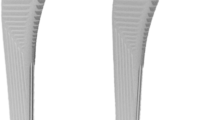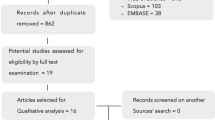Abstract
Due to anatomical and surgical constrains the implant placement may not be parallel to each other always. Non-parallel implants are subjected to detrimental stresses at implant bone interface. Also depending on type of implant material i.e. titanium or zirconium, stresses tend to vary due to change in physical and mechanical properties. Hence stress analysis at implant bone interface between different parallel and non-parallel implants becomes significant. Evaluation and comparison of stress distribution in the bone around two parallel and non-parallel titanium and zirconium dental implants on axial and non-axial loading supporting three unit fixed prosthesis. Three dimensional finite element models (M1, M2, M3) were made of three differently angulated implants in ANSYS (11.0 Version) software and P4 processor with a speed of 3 GHz and 3 Gb RAM hardware, common for titanium and zirconium implants. Stress around the implants was analyzed on an axial load of 200 N and a non-axial load of 50 N. In both titanium and zirconium implants on axial loading in cortical bone, higher stresses were observed in M3 followed by M2 and M1. On non-axial loading higher stresses were observed in M2, followed by M3 and M1. In both titanium and zirconium implants on axial and non-axial loading in cancellous bone stresses were higher in M3 followed by M2 and M1. Zirconium implants showed lower stresses in cortical bone and higher stresses in cancellous bone compared to titanium implants. Over all Stresses in the bone were more due to titanium implants than zirconium implants. Zirconium implants led to lower peri-implant stresses than titanium implants.





























Similar content being viewed by others
References
Geng J, Yan W, Xu W (2008) Application of the finite element method in implant dentistry, 1st edn. Springer, Berlin
Oliva J, Oliva X, Oliva JD (2008) Zirconia implants and all-ceramic restorations for the esthetic replacement of the maxillary central incisors. Eur J Esthet Dent 3:174–185
Papavasiliou G, Kamposiora P, Bayne SC, Felton DA (1996) Three-dimensional finite element analysis of stress distribution around single tooth implants as a function of bony support, prosthesis type and loading during function. J Prosthet Dent 76:633–640
Meijer HJA, Starmans FJM, Steen WHA, Bosman F (1996) Loading conditions of endosseous implants in an edentulous human mandible: a three-dimensional finite element analysis. J Oral Rehabil 23:757–763
Canay S, Hersek N, Akpinar I, Asik Z (1996) Comparison of stress distribution around vertical and angled implants with finite element analysis. Quintessence Int 27:591–598
ten Bruggenkate CM, Sutter F, Oosterbeek HS, Schroeder A (1992) Indications for angled implants. J Prosthet Dent 67:85–93
Winter W, Heckmann SM, Weber HP (2004) A time-dependent healing function for immediate loaded implants. J Biomech 37:1861–1867 2004 Dec
Eser A, Tonuk E, Akca K, Cehreli MC (2010) “Predicting time-dependent remodeling of bone around immediately loaded dental implants with different designs”. Med Eng Phys 2010 Jan; 32: 22–31. Epub 2009 Nov 1
Cook SD, Klawitter JJ, Weinstein AM (1982) A model for the implant bone interface characteristics of porous dental implants. J Dent Res 61:1006–1009
Lozada L, Abbate MF, Pizzarello FA, James RA (1994) Comparative three-dimensional analysis of two finite element endosseous implant designs. J Oral Implantol 20:315–321
Meijer HJA, Kuiper JH, Starmans FJM, Bosman F (1992) Stress distribution around dental implants: influence of superstructure, length of implants and height of mandible. J Prosthet Dent 68:96–102
Sutpideler M, Eckert SE, Zobitz M, An KN (2004) Finite element analysis of effect of prosthesis height, angle of force application, and implant offset on supporting bone. Int J Oral Maxillofac Implants 19:819–825
Geng J-P, Tan KesonBC, Liu G-R (2001) Application of finite element analysis in implant dentistry: a review of the literature. J Prosthet Dent 85:585–598
Rieger MR, Fareed K, Adams WK, Tanquist RA (1989) Bone stress distribution for three endosseous implants. J Prosthet Dent 61:223–228
Clelland NL, Gilat A, McGlumphy EA, Brantley WA (1993) A photoelastic and stain gauge analysis of angled abutments for an implant system. Int J Oral Maxillofac Implants 8:541–548
Stegaroiu R, Sato T, Kusakari H, Miyakawa O (1998) Influence of restoration type on stress distribution in bone around implants: a three dimensional finite element analysis. Int J Oral Maxillofac Implants 13:82–90
Author information
Authors and Affiliations
Corresponding author
Rights and permissions
About this article
Cite this article
Gujjarlapudi, M.C., Nunna, N.V., Manne, S.D. et al. Predicting Peri-implant Stresses Around Titanium and Zirconium Dental Implants—A Finite Element Analysis. J Indian Prosthodont Soc 13, 196–204 (2013). https://doi.org/10.1007/s13191-013-0257-7
Received:
Accepted:
Published:
Issue Date:
DOI: https://doi.org/10.1007/s13191-013-0257-7




